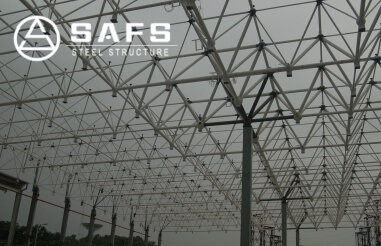Dapeng Town Industrial Park, Tongshan District, Xuzhou City, Jiangsu Province, China
The main loads of grid steel structure are divided into three types, namely action load, permanent load and variable load. Generally speaking, the load includes the deadweight of the grid shell structure, the deadweight of the roof maintenance structure, the load of the hanging equipment pipe and the horseway load. For the storage silo, there are four main variable loads, namely roof load, snow load, wind load and dust load. So how to calculate the load of grid steel structure?

The load calculation of grid steel structure is a complex process, which needs to consider a variety of load combinations. The following provides you with a clearer explanation:
(1) Structural deadweight: Calculate the weight according to the size and material density of each grid component. For example, the density of steel is generally taken as 7850kg/m³.
(2) Roof load: Includes the deadweight of the roof panel and the weight of the possible ceiling, insulation layer, etc. Different roof materials have different weights, such as color steel plate, concrete slab, etc. have their own standard weights.
(3) Weight of hanging equipment: If there are pipes, lamps and other equipment hanging on the grid, their weight needs to be calculated separately and reasonably distributed to each node of the grid.
(1) Roof live load: Generally, the value is determined according to the building function and specification requirements. For example, the live load of an ordinary workshop roof may be 0.5kN/m² or higher. The specific value needs to refer to the relevant building design specifications.
(2) Crane load: If there is a crane running under the grid, the maximum lifting weight of the crane and the impact load on the grid during operation need to be considered.
The wind load mainly acts on the windward area of the grid. The calculation formula is usually: q=μsμzμtW0, where μs is the body coefficient, which is related to the shape and windward area of the grid; μz is the height variation coefficient, which takes into account the influence of ground roughness and height on wind speed; μt is the pulsation increase coefficient; 0W0 is the basic wind pressure, which is selected according to the local wind pressure standard value.
The calculation of snow load is relatively simple and is determined according to the local snow distribution and snow density. Generally speaking, the calculation formula of snow load is: S=hρg, where h is the snow depth, ρ is the snow density, and g is the acceleration of gravity.
For grid steel structures located in earthquake-fortified areas, earthquake action needs to be considered. The calculation of earthquake action is relatively complicated, and usually adopts the vibration mode decomposition response spectrum method or time history analysis method. It is necessary to consider factors such as the structural form, mass distribution, and site conditions of the grid.
In actual design, it is not a simple addition of various loads, but a load combination according to different working conditions. Common load combinations are:
① Permanent load + variable load (wind load and earthquake action are not considered).
② Permanent load + 0.6 variable load + wind load.
③ Permanent load + earthquake action.
In short, the load calculation of grid steel structure needs to comprehensively consider multiple factors to ensure the safety and economy of the structure. Since the calculation process is relatively complicated, it is usually necessary to use professional structural design software to assist in the calculation.